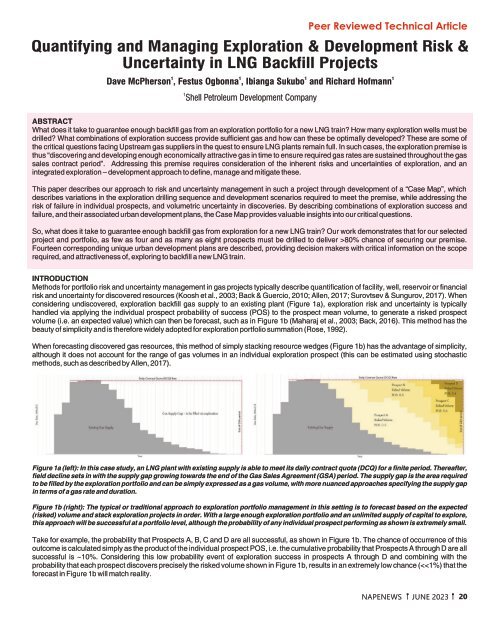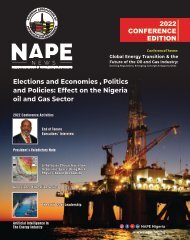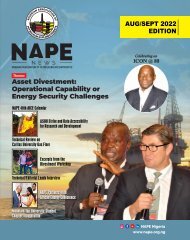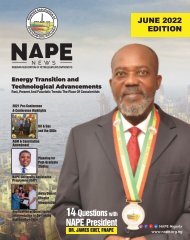NAPENews Magazine June 2023 Edition
NAPENews Magazine June 2023 Edition
NAPENews Magazine June 2023 Edition
You also want an ePaper? Increase the reach of your titles
YUMPU automatically turns print PDFs into web optimized ePapers that Google loves.
Peer Reviewed Technical Article<br />
Quantifying and Managing Exploration & Development Risk &<br />
Uncertainty in LNG Backfill Projects<br />
1 1 1 1<br />
Dave McPherson , Festus Ogbonna , Ibianga Sukubo and Richard Hofmann<br />
1<br />
Shell Petroleum Development Company<br />
ABSTRACT<br />
What does it take to guarantee enough backfill gas from an exploration portfolio for a new LNG train? How many exploration wells must be<br />
drilled? What combinations of exploration success provide sufficient gas and how can these be optimally developed? These are some of<br />
the critical questions facing Upstream gas suppliers in the quest to ensure LNG plants remain full. In such cases, the exploration premise is<br />
thus “discovering and developing enough economically attractive gas in time to ensure required gas rates are sustained throughout the gas<br />
sales contract period”. Addressing this premise requires consideration of the inherent risks and uncertainties of exploration, and an<br />
integrated exploration – development approach to define, manage and mitigate these.<br />
This paper describes our approach to risk and uncertainty management in such a project through development of a “Case Map”, which<br />
describes variations in the exploration drilling sequence and development scenarios required to meet the premise, while addressing the<br />
risk of failure in individual prospects, and volumetric uncertainty in discoveries. By describing combinations of exploration success and<br />
failure, and their associated urban development plans, the Case Map provides valuable insights into our critical questions.<br />
So, what does it take to guarantee enough backfill gas from exploration for a new LNG train? Our work demonstrates that for our selected<br />
project and portfolio, as few as four and as many as eight prospects must be drilled to deliver >80% chance of securing our premise.<br />
Fourteen corresponding unique urban development plans are described, providing decision makers with critical information on the scope<br />
required, and attractiveness of, exploring to backfill a new LNG train.<br />
INTRODUCTION<br />
Methods for portfolio risk and uncertainty management in gas projects typically describe quantification of facility, well, reservoir or financial<br />
risk and uncertainty for discovered resources (Koosh et al., 2003; Back & Guercio, 2010; Allen, 2017; Surovtsev & Sungurov, 2017). When<br />
considering undiscovered, exploration backfill gas supply to an existing plant (Figure 1a), exploration risk and uncertainty is typically<br />
handled via applying the individual prospect probability of success (POS) to the prospect mean volume, to generate a risked prospect<br />
volume (i.e. an expected value) which can then be forecast, such as in Figure 1b (Maharaj et al., 2003; Back, 2016). This method has the<br />
beauty of simplicity and is therefore widely adopted for exploration portfolio summation (Rose, 1992).<br />
When forecasting discovered gas resources, this method of simply stacking resource wedges (Figure 1b) has the advantage of simplicity,<br />
although it does not account for the range of gas volumes in an individual exploration prospect (this can be estimated using stochastic<br />
methods, such as described by Allen, 2017).<br />
Figure 1a (left): In this case study, an LNG plant with existing supply is able to meet its daily contract quota (DCQ) for a finite period. Thereafter,<br />
field decline sets in with the supply gap growing towards the end of the Gas Sales Agreement (GSA) period. The supply gap is the area required<br />
to be filled by the exploration portfolio and can be simply expressed as a gas volume, with more nuanced approaches specifying the supply gap<br />
in terms of a gas rate and duration.<br />
Figure 1b (right): The typical or traditional approach to exploration portfolio management in this setting is to forecast based on the expected<br />
(risked) volume and stack exploration projects in order. With a large enough exploration portfolio and an unlimited supply of capital to explore,<br />
this approach will be successful at a portfolio level, although the probability of any individual prospect performing as shown is extremely small.<br />
Take for example, the probability that Prospects A, B, C and D are all successful, as shown in Figure 1b. The chance of occurrence of this<br />
outcome is calculated simply as the product of the individual prospect POS, i.e. the cumulative probability that Prospects A through D are all<br />
successful is ~10%. Considering this low probability event of exploration success in prospects A through D and combining with the<br />
probability that each prospect discovers precisely the risked volume shown in Figure 1b, results in an extremely low chance (










